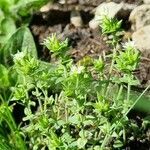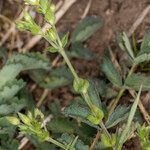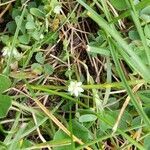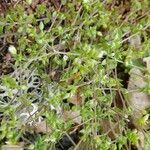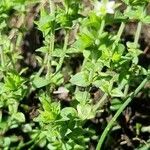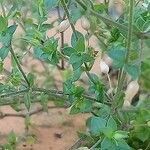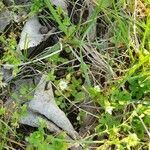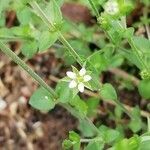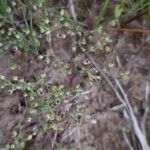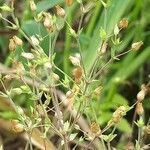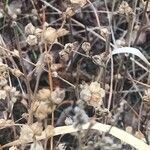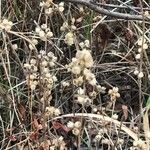Diffuse, delicate or wiry, puberulent annual 5–30 cm; lvs usually 8–10 pairs, 3–8 × 3–5 mm, ovate, acute, sparsely scabrid-puberulent, 3–5-nerved, mostly much shorter than the internodes; infl short or extending to the middle of the stem; bracts leafy, pedicels slender, 4–8 mm; sep 2.5–4 mm, lance-ovate, acuminate, 3–5-nerved, somewhat carinate, scarious-margined, scabrid-puberulent or often glandular; pet usually shorter than the sep; fr ovoid-conic, ± exceeding the sep, dehiscent to an uncertain depth by 6 teeth or valves; seed plump, 0.4–0.6 mm, gray-black or reddish-brown, tessellate-tuberculate; tetraploid on x=10. Native of Eurasia, now found throughout most of temperate N. Amer. as a weed in sandy or stony places. May–Aug. A delicate, diploid phase with relatively small lvs, fls and frs, less common in our range than typical A. serpyllifolia, is var. tenuior Mert. & Koch. (A. leptoclados)
Herbs annual or biennial. Principal roots slender, with numerous smaller branches. Stems caespitose, erect or diffuse, 10--30 cm, densely white villous. Leaves sessile; leaf blade ovate, 4--12 × 3--7 mm, both surfaces glabrous or sparsely villous, 3-veined abaxially, base attenuate, margin ciliate, apex acute; proximal cauline leaves larger, distal ones smaller. Cymes many flowered; bracts ovate, 3--7 mm, herbaceous, usually densely villous. Pedicel slender, ca. 1 cm, densely villous or glandular pubescent. Sepals 5, lanceolate, 3--4 mm, villous abaxially, veins 3, impressed, margin membranous, apex acute. Petals 5, white, obovate, 1/3--1/2 as long as sepals, apex obtuse. Stamens 10, shorter than sepals. Ovary ovoid. Styles 3, linear. Capsule ovoid, equaling persistent sepals. Seeds pale brown, reniform, small, tuberculate with raised papillae. Fl. Jun--Aug, fr. Aug--Sep.
Herb, annual or biennial, with slender, branching tap root, scabridulous, rarely sparsely glandular-hairy above. Stems diffuse, but often bushy, lax, 2–30 cm long. Leaves ovate, sessile or subsessile, 1-veined, ciliate, 3–5 (–10) mm long, 2–3 (–6) mm wide. Inflorescence usually diffuse; bracts herbaceous. Flowers 5–8 mm diam.; pedicels 2–5 mm long, ±erect in fruit. Calyx scabrous, sparsely glandular-puberulent. Sepals 3–4 mm long, ovate-lanceolate, acute, hairy, 3–5-veined; inner sepals with scarious margins. Petals 65% length of sepals, white, ovate to narrowly obovate. Styles 3. Capsule 4–5 mm long, 1.5–2 mm diam., urceolate-ampulliform, with firm, curved walls. Seeds 0.5–0.7 mm long, black or dark red, bluntly tuberculate. See also Green (1994: 92).
Annual or biennial herb, puberulous to glandular pubescent in upper part, up to 25 cm, usually richly branched from the base, ascending or erect. Lower leaves petiolate, spathu-late, early withering, the upper leaves ovate-triangular, acute to acuminate, sessile, 3-5-veined, 3-7 mm long, greyish green hairy. Inflorescence often monochasial, few-to many-flowered; bracts foliaceous; pedicels 2-7 mm. Sepals ovate-narrowly elliptic, acute to acuminate, 3-4 mm, 3-5-veined. Petals ovate, shorter than sepals. Capsule ovoid-conical to subglobose, abruptly narrowed towards apex, walls rather brittle. Seeds tuberculate, less than 1 mm diameter.
Annual. Stems erect to ascending, 2-15-(30) cm tall; hairs eglandular, very short, backwardly curved. Lvs distant, lanceolate to ovate, acute, (1)-3-5-veined, with scabrid hairs, (2)-3-5 × (1)-2-3 mm. Infl. compact at flowering, elongating at fruiting. Bracts leaflike, herbaceous. Sepals 5, ovate-acuminate, 2-4 mm long, with scabrid hairs, 3-5-veined; midvein prominent; margin scarious. Petals 5, 1/2-⅔ length of sepals, narrow-elliptic, white, entire. Styles 3. Capsule flask-shaped, swollen at base, dehiscing by 6 short teeth, = or slightly > sepals. Seeds dark brown, tuberculate, 0.5 mm long; strophiole 0.
An annual herb. Sometimes it takes 2 years to complete its life cycle. The stems are erect or curve upwards. It is 3-15 cm high. It branches at the base. The lower leaves have short leaf stalks. The upper leaves do not have leaf stalks. The leaf blade is broad and oval. It is 3-6 mm long. It tapers to the tip. There are usually 3-5 veins. There are 5 sepals and 5 petals. They are white. The fruit is a capsule which is flask shaped. It is wider at the base. It splits open with 6 teeth. The seeds are about 0.5 mm across. They are lumpy and dark brown.
